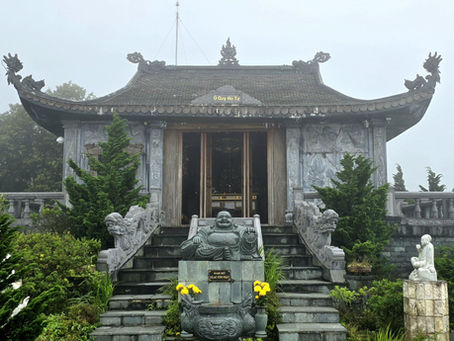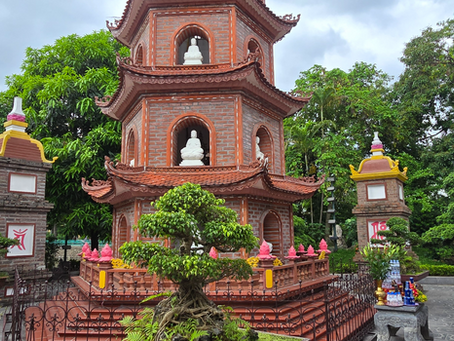top of page

GLOBAL SHANANIGANS

Search


Hoi An Ancient Town
The City of Lanterns shimmers along the Thu Bon River, where centuries old timber houses and winding alleys seem frozen between past and present. Hoi An has drawn travellers for over 2000 years, its history etched in buried ceramics and whispered legends. Beneath the glow of lanterns, the streets still carry the energy of centuries of trade, daily life and the people who shaped the town into the vibrant place it is today.
Shannon


Co Loa Ancient Citadel
Dating back to 208 BC, Co Loa Citadel rose as the heart of the ancient Au Lac kingdom under the legendary King An Duong Vuong. Legend tells of a mighty crossbow and protective magic, yet even these could not save the kingdom from betrayal and ruin, a story of power, ambition and ghosts that still linger over the northern plains.
Shannon


One Pillar Pagoda
Regarded as one of Vietnam’s most iconic architectural treasures, the One Pillar Pagoda rises like a solitary lotus from the water. Built in 1049 AD by Emperor Lý Thái Tông and dedicated to Quan Âm, the Bodhisattva of Compassion, the shrine has long drawn worshippers seeking fertility, health and divine favour, its slender silhouette a silent witness to a millennium of faith and history.
Shannon


The Temple of Literature
Founded in 1070 AD under Emperor Lý Thánh Tông, the Temple of Literature honours Confucius and his disciples, its courtyards, banyan trees and lotus ponds echoing centuries of scholarly pursuit. Later home to Vietnam’s first university, it carries the weight of history and the whispered presence of generations of students, a place where wisdom feels alive, shadowed by the spirits of those who once walked its paths.
Shannon


Fansipan Mountain Temples
The temples atop Fansipan Mountain form part of the Sun World Fansipan Legend spiritual complex, a remarkable network of religious structures built to honour Vietnam’s deep-rooted Buddhist traditions. Perched at over 3000 meters above sea level, this complex has transformed the “Roof of Indochina” from a rugged trekking destination into a place of pilgrimage.
Shannon


Thành Chương's Viet Palace
Tucked away on Sóc Sơn Mountain, roughly 30km's north of Hanoi, Thành Chương’s Viet Palace is far more than a museum or art gallery, it is a cultural time capsule and a living work of art, meticulously crafted by the celebrated contemporary Vietnamese painter Thành Chương.
Shannon


Cat Cat Village
Cat Cát Village lies in the misty mountains of northern Vietnam, known for its cascading waterfalls, terraced hillsides and narrow stone paths that wind through the valley. The landscape, shaped by water and cloud, gives the village a magical atmosphere that draws travellers seeking both beauty and stillness.
Shannon


Bao Lac
Bảo Lạc Town, near Vietnam’s northern border with China, hides a blood-soaked past beneath its calm surface. For centuries, this rugged land was home to fiercely independent Tày, Nùng, Hmong, and Dao tribes who lived and died resisting Vietnamese and Chinese domination. Imperial forces repeatedly tried to crush their autonomy, but the mountains ran red as rebellion flared again and again.
Shannon


Hanoi Old Quarter
A living, breathing time capsule, Hà Nội Old Quarter is a tapestry woven from centuries of colonial exploitation, Confucian rituals, dynastic collapses and wartime destruction. Despite relentless modernisation and gentrification, the Old Quarter remains defiantly alive. It preserves not just Hà Nội’s heritage but the very essence of Vietnam’s ability to adapt and endure.
Shannon


Hoàn Kiếm Sword Lake and the Turtle Tower
Nestled in Hanoi’s bustling Old Quarter, Hoàn Kiếm Lake offers a serene escape from the city's chaos. This natural freshwater lake, stretching 700 metres across 12 hectares, has been a cultural and historical anchor for centuries, its origins possibly predating Hanoi itself by over a thousand years.
Shannon


Carved in Time - Khuổi Ky Stone Village
Known for its striking stone architecture and deeply rooted cultural traditions, Khuổi Ky’s origins trace back over 400 years and was established by the ancient Tay ethnic tribe, after 2,000 years of hardship and migration from the southern regions of China and Cambodia. The Tay people, one of Vietnam’s oldest and most culturally rich ethnic groups, are believed to have journeyed across generations, seeking fertile land and spiritual sanctuary.
Shannon


Ô Quy Hồ Heavens Gate
Often bound in heavy fog, Cổng Trời Ô Quy Hồ or Heavens Gate, is a lesser known temple complex and viewpoint, situated atop the Ô Quy Hồ Pass, one of Vietnam's most majestic mountain passes. Located approximately 18 km's from Sapa town, this pass connects the provinces of Lào Cai and Lai Châu. Perched at an elevation of 2035 metres, it offers visitors panoramic vistas of the Hoàng Liên Sơn mountain range, including glimpses of Fansipan, the highest peak in Indochina.
Shannon


Bạch Mã Temple
Bạch Mã Temple, the oldest temple in Hanoi’s Old Quarter, traces its origins back to the year 1010, during the reign of Emperor Lý Thái Tổ. It is one of four sacred temples in the city, constructed to stand as a spiritual guardian for the eastern side of ancient Thang Long (modern-day Hanoi) and was carefully chosen according to the principles of geomancy and the cardinal points.
Shannon


Hỏa Lò Prison
Constructed by the French in 1896 as part of their broader strategy to subjugate Vietnam under colonial rule, Hỏa Lò Prison was built to break the will of Vietnamese revolutionaries and political dissidents. Intended to hold 450 inmates, it regularly crammed in over 2000, locking men and women into rotting, airless cells that stank of urine, sweat and blood. It became a crucible of suffering, where countless resistance leaders endured torture, starvation and isolation.
Shannon


Bridge Between Worlds - Ngọc Sơn Temple
Tucked away on a small jade-green islet in the heart of Hanoi’s Hoàn Kiếm Lake, Ngọc Sơn Temple (“Temple of the Jade Mountain”) is a portal into Vietnam’s tangled history of war, mysticism, and legend. Ngọc Sơn Temple rose in 1841 to honour the national hero General Trần Hưng Đạo, who crushed Mongol invaders in the 13th century, and its story is woven tightly with both fact and fascinating folklore.
Shannon


The Temple of the Dog
Thủy Trung Tiên Temple, once known as Cẩu Nhi Temple, rests on a quiet, tree-lined island on Trúc Bạch Lake, just north of Hanoi’s West Lake. Modest in size but heavy with history, the temple dates back over 1000 years and is one of the capital’s oldest surviving spiritual sites. Few visitors realise it’s built on the remnants of a forgotten cult, one centred on the worship of a dog.
Shannon


H’Mong King Palace - Fortress of the Opium King
Deep within the misty limestone mountains of Vietnam’s northern highlands, the H’Mong Kings' Palace stands as a solemn relic of power, ambition & tribal legacy. Also known as the Vuong Family Mansion (Dinh Vua Mèo), construction commenced in 1898 under the directive of H’Mong leader Vương Chính Đức, a powerful warlord and opium King.
Shannon


The Legacy of Trấn Quốc Pagoda
With its origins stretching back over 1500 years, Trấn Quốc Pagoda holds the distinction of being the oldest Buddhist temple in the country. It was originally built around 545 AD during the reign of Emperor Lý Nam Đế, who commissioned its construction as part of a broader vision to legitimise Vietnamese sovereignty in the midst of political upheaval and resistance against Chinese rule.
Shannon


The Legacy of King Lê Thái Tổ
This quiet and understated shrine on the southeastern banks of Hoàn Kiếm Lake pays homage to King Lê Thái Tổ, the revered 15th-century General-turned-Emperor. He liberated Vietnam from Chinese rule and founded the Later Lê Dynasty, the country's longest ruling imperial line. Built in 1894, the Lê King Temple is a quiet portal into Vietnam’s post-colonial rebirth, layered with political significance and tales of divine destiny, rebellion and the enduring power of myth.
Shannon


Beneath the Dragon - Imperial Citadel of Thăng Long
Constructed on the remains of a 7th century Chinese fortress, the Thăng Long Imperial Citadel was built on strategic reclaimed river lands on the lower Red River Delta and for nearly 13 centuries, remained the regional powerhouse of Northern Vietnamese political & military domination. Shortly after his ascension to the throne, Emperor Lý Thái Tổ declared a royal decree in the year 1010, to move the capital from Hoa Lư and establish a new Imperial City for the Lý Dynasty.
Shannon
bottom of page